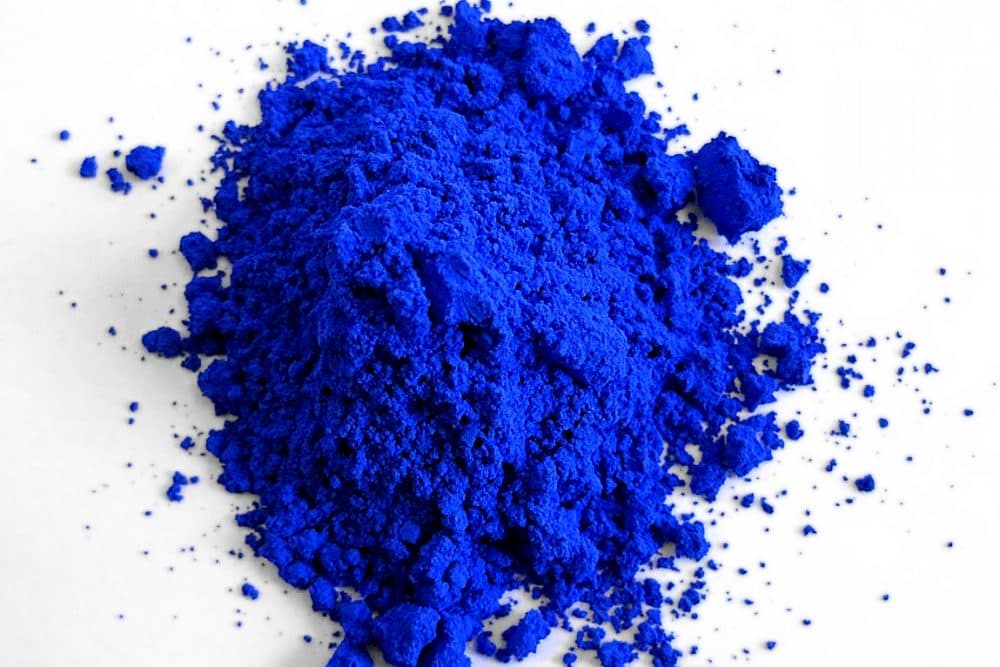Advertisement
Discovery Of 1st New Blue Pigment In 200 Years Leads To Quest For Elusive Red

We see colors in nature: a blue sky, a red frog, a peacock's feathers. But those colors are created by the reflection of light off atoms. To reproduce color for paints, cosmetics or dyes, we need pigment. Finding natural ones or creating them synthetically is as complicated as it is elusive.
The pigments need to be stable — not fading in light, or disintegrating with heat. And they need to be nontoxic. So when scientist Mas Subramanian accidentally discovered a new blue — meeting all those criteria — a few years back, he was hailed as a rock star in the world of colors. Now, he's on a quest for red.
Subramanian (@Mas_OregonState) joins Here & Now's Robin Young from Oregon State University, where he made the discovery, to talk about color.
Interview Highlights
On finding the new color, YInMn blue
"Well, I asked my graduate student to mix three components. One is yttrium oxide, which is white; indium oxide, which is yellow; and manganese oxide, which is black. So the next morning I was in the lab, and he pulled the sample of the furnace, 2,300 degrees Fahrenheit, and I was shocked because all the samples came out vivid blue. In the beginning, I thought he made a mistake. I thought it would be like brown or black. Then I asked him to repeat the experiment and we could again get the blue. Blue is the most difficult color to make, and we found it extremely stable, so that made me really excited, and we find this to be the first new blue pigment in 200 years."
On why it's so hard to make pigments
"There are only very few blue pigments known to mankind now. For example, most of the blue you see in nature, like a blue sky, has got no pigment. It's just a scattering of the light. You think about the bluebird or peacock or morpho butterflies, they don't have an atom of pigment in their beings or in their feathers. You can't make blue easily."
On what it was like to discover a new color
"It was something. I also didn't think so much about it before I discovered this blue. I always thought all the colors had been discovered because we see all the colors in nature. For 200 years, many companies, many laboratories have been trying to create a new blue which is nontoxic. Cobalt really is quite durable, but it's got cobalt, which is carcinogenic. So it was really unbelievable."
The color has properties that have companies like HP, Nike and Chanel calling.
"As soon as we discovered this blue pigment, I got a call from Shepherd Color Company in Ohio. They called me and said they would like to our test pigments for durability and also the other spectral properties, to make sure that it can be used because they manufacture of cobalt blue. So they came and they tested for two years under various conditions. Under the hot sun in Florida, in California and also in Australia. Finally they found this pigment does not fade. It is quite stable. And also they found that this pigment can deflect heat. So if you paint using our pigment, like a roof of a car or the roof of the house, it keeps the plates cooler. This is the first blue pigment ever made which can deflect heat."
"In the beginning, I thought he made a mistake. I thought it would be like brown or black. Then I asked him to repeat the experiment and we could again get the blue. "
Mas Subramanian
How much does it cost to create YInMn blue?
"Right now, the cost of the YInMn blue is high because of the indium price. Because indium is used in only a few applications now, on computer screens. So the availability of the indium is always limited to very pure indium oxide. There's a lot of interest now in finding a way to get indium materials which are not as high pure as the one to clarify electronics for the pigment applications. One more thing, you don't need to have 100 percent pigment in your paint. You can mix this with the other colors, white for example. It will deflect heat, so you can have lots of possibilities with this pigment."
On his latest search, and the difficulties of creating red pigments
"The reason most of the red pigments, which are really stable — they are containing some toxic elements like cadmium, cadmium red. It can be a vermilion, which is based on the mercury, and they are, again, toxic. And there are some lead pigments, which, again, they're toxic. So there is a race now to find new red, which can replace all this, or it can lead to a billion-dollar business. That's what the pigment industry says."
On how the discovery of YInMn blue has changed him
"You know, I have made several discoveries, from superconductors to dielectrics to catalysis. But this discovery is really special. My wife, who is an artist and also a chemist, she uses all my pigments. And now, every museum she goes, I spend more time there watching all these paintings, which especially has blue. For example, Van Gogh's 'Starry Night' or 'Irises.' All those kinds of paintings, like 'What blue pigment did they use here?'
"What can I say? I'm really glad I discovered YInMn blue. ... I may or may not become rich with this discovery, but discovery has enriched my life [in] so many ways. As a scientist, my goal is to make the life more safer and also more enjoyable, at the same time, more efficient, so that we can all enjoy whatever we want to do."
This article was originally published on May 14, 2018.
This segment aired on May 14, 2018.